Effect of Variation of SiC Reinforcement on Wear Behaviour of AZ91 Alloy Composites
Abstract
:1. Introduction
2. Material and Method
3. Results and Discussion
4. Conclusions
- The microhardness of the SiC reinforced AZ91 composites was more than the unreinforced AZ91 alloy due to the presence of a hard particle in a soft matrix.
- The wear rate and coefficient of friction of the SiC reinforced composites was lower than the unreinforced composites. This is due to the higher hardness and grain refinement in SiCp in composites.
- The wear rate increased with an increase in normal loads due to the increase in plastic deformation at higher load.
- The friction coefficient decreased with an increase in normal load and sliding distance due to a decrease in the mating surfaces’ asperities.
- The wear rate at velocity 1.39 m/s was higher than that at velocity 2.60 m/s in alloy and composites, and the effect of differences in velocity on wear rate decreased with the increase in normal loads. This may be because the effect of load on wear rate is higher than velocity and increase in hardness on addition of SiCp.
- The wear behaviour at velocity 1.39 m/s was dominated by oxidation and delamination wear whereas at velocity 2.6 m/s wear behaviour was dominated by abrasion and adhesion wear due to the induction of high energy at higher velocity and load.
- It was observed from SEM that the plastic deformation and smearing occurred at higher load and sliding velocity due to severe plastic deformation on the surface.
Author Contributions
Funding
Institutional Review Board Statement
Informed Consent Statement
Data Availability Statement
Conflicts of Interest
References
- García-Rodríguez, S.; Torres, B.; Maroto, A.; López, A.; Otero, E.; Rams, J. Dry sliding wear behavior of globular AZ91 magnesium alloy and AZ91/SiCp composites. Wear 2017, 390–391, 1–10. [Google Scholar] [CrossRef]
- Jiang, Q.; Wang, H.; Ma, B.; Wang, Y.; Zhao, F. Fabrication of B4C particulate reinforced magnesium matrix composite by powder metallurgy. J. Alloy. Compd. 2005, 386, 177–181. [Google Scholar] [CrossRef]
- Kumar, A.; Kumar, S.; Mukhopadhyay, N.K. Casting and characterization of TiC particulate reinforced AZ91 magnesium alloy metal matrix composite through stir casting process. Int. J. Mech. Eng. Technol. 2018, 9, 856–863. [Google Scholar]
- Kumar, A.; Kumar, S.; Mukhopadhyay, N.K.; Yadav, A.; Winczek, J. Effect of SiC Reinforcement and Its Variation on the Mechanical Characteristics of AZ91 Composites. Materials 2020, 13, 4913. [Google Scholar] [CrossRef]
- Kumar, A.; Kumar, S.; Mukhopadhyay, N. Introduction to magnesium alloy processing technology and development of low-cost stir casting process for magnesium alloy and its composites. J. Magnes. Alloy. 2018, 6, 245–254. [Google Scholar] [CrossRef]
- Saleh, B.; Jiang, J.; Fathi, R.; Xu, Q.; Wang, L.; Ma, A. Study of the microstructure and mechanical characteristics of AZ91–SiCp composites fabricated by stir casting. Arch. Civ. Mech. Eng. 2020, 20, 1–14. [Google Scholar] [CrossRef]
- Aravindan, S.; Rao, P.; Ponappa, K. Evaluation of physical and mechanical properties of AZ91D/SiC composites by two step stir casting process. J. Magnes. Alloy. 2015, 3, 52–62. [Google Scholar] [CrossRef] [Green Version]
- Chen, H.; Alpas, A. Sliding wear map for the magnesium alloy Mg-9Al-0.9 Zn (AZ91). Wear 2000, 246, 106–116. [Google Scholar] [CrossRef]
- Sharma, S.; Anand, B.; Krishna, M. Evaluation of sliding wear behaviour of feldspar particle-reinforced magnesium alloy composites. Wear 2000, 241, 33–40. [Google Scholar] [CrossRef]
- Thakur, S.K.; Dhindaw, B.K. The influence of interfacial characteristics between SiCp and Mg/Al metal matrix on wear, coefficient of friction and microhardness. Wear 2001, 247, 191–201. [Google Scholar] [CrossRef]
- Rittner, M.N. Expanding World Markets for MMCs. JOM 2000, 52, 43. [Google Scholar] [CrossRef]
- Lindroos, V.; Talvitie, M. Recent advances in metal matrix composites. J. Mater. Process. Technol. 1995, 53, 273–284. [Google Scholar] [CrossRef]
- Lim, C.; Lim, S.C.; Gupta, M. Wear behaviour of SiCp-reinforced magnesium matrix composites. Wear 2003, 255, 629–637. [Google Scholar] [CrossRef]
- Saravanan, R.; Surappa, M. Fabrication and characterisation of pure magnesium-30 vol.% SiCP particle composite. Mater. Sci. Eng. A 2000, 276, 108–116. [Google Scholar] [CrossRef]
- Wang, C.; Deng, K.; Bai, Y. Microstructure, and Mechanical and Wear Properties of Grp/AZ91 Magnesium Matrix Composites. Materials 2019, 12, 1190. [Google Scholar] [CrossRef] [PubMed] [Green Version]
- Patil, N.A.; Pedapati, S.R.; Mamat, O.B.; Lubis, A.M.H.S. Effect of SiC/Fly Ash Reinforcement on Surface Properties of Aluminum 7075 Hybrid Composites. Coatings 2020, 10, 541. [Google Scholar] [CrossRef]
- Luo, A.A. Recent magnesium alloy development for elevated temperature applications. Int. Mater. Rev. 2004, 49, 13–30. [Google Scholar] [CrossRef]
- Cole, G.S. Issues that Influence Magnesium’s Use in the Automotive Industry. Mater. Sci. Forum 2003, 419–422, 43–50. [Google Scholar] [CrossRef]
- Kumar, S.; Yadav, A.; Patel, V.; Nahak, B.; Kumar, A. Mechanical behaviour of SiC particulate reinforced Cu alloy-based metal matrix composite. Mater. Today Proc. 2020. [Google Scholar] [CrossRef]
- Wang, W.J. The tribological and wear behavior of aluminum matrix composites. Acta Metall. Sin. 1998, 34, 1178–1182. [Google Scholar]
- Kok, M.; Özdin, K. Wear resistance of aluminium alloy and its composites reinforced by Al2O3 particles. J. Mater. Process. Technol. 2007, 183, 301–309. [Google Scholar] [CrossRef]
- Jasim, K.; Dwarakadasa, E. Wear in Al-Si alloys under dry sliding conditions. Wear 1987, 119, 119–130. [Google Scholar] [CrossRef]
- Lu, L.; Lim, C.; Yeong, W. Effect of reinforcements on strength of Mg9%Al composites. Compos. Struct. 2004, 66, 41–45. [Google Scholar] [CrossRef]
- Poddar, P.; Srivastava, V.; De, P.; Sahoo, K. Processing and mechanical properties of SiC reinforced cast magnesium matrix composites by stir casting process. Mater. Sci. Eng. A 2007, 460, 357–364. [Google Scholar] [CrossRef]
- Perez, P.; Garces, G.; Adeva, P. Mechanical properties of Mg−10(vol.%)Ti composite. Compos. Sci. Technol. 2004, 64, 145–151. [Google Scholar] [CrossRef]
- Hu, Y.; Rao, L. Effect of particulate reinforcement on wear behavior of magnesium matrix composites. Trans. Nonferrous Met. Soc. China 2012, 22, 2659–2664. [Google Scholar] [CrossRef]
- Lim, C.; Leo, D.; Ang, J.; Gupta, M. Wear of magnesium composites reinforced with nano-sized alumina particulates. Wear 2005, 259, 620–625. [Google Scholar] [CrossRef]
- Habibnejad-Korayem, M.; Mahmudi, R.; Ghasemi, H.; Poole, W. Tribological behavior of pure Mg and AZ31 magnesium alloy strengthened by Al2O3 nano-particles. Wear 2010, 268, 405–412. [Google Scholar] [CrossRef]
- Falcon-Franco, L.; Bedolla-Becerril, E.; Lemus-Ruiz, J.; Gonzalez-Rodríguez, J.; Guardian, R.; Rosales, I. Wear performance of TiC as reinforcement of a magnesium alloy matrix composite. Compos. Part B Eng. 2011, 42, 275–279. [Google Scholar] [CrossRef]
- Alahelisten, A.; Bergman, F.; Olsson, M.; Hogmark, S. On the wear of aluminium and magnesium metal matrix composites. Wear 1993, 165, 221–226. [Google Scholar] [CrossRef]
- Kim, Y.S.; Kim, K.T.; Kim, S.J.; Kim, J.D. Microstructures and Wear Properties of Al Matrix Composites Fabricated by Two Different Processes. Mater. Sci. Forum 2006, 510–511, 202–205. [Google Scholar] [CrossRef]
- Kumar, A.; Kumar, V.; Kumar, A.; Nahak, B.; Singh, R. Investigation of mechanical and tribological performance of marble dust 7075 aluminium alloy composites. Mater. Today Proc. 2021. [Google Scholar] [CrossRef]
- Kumar, A.; Kumar, M.; Patnaik, A.; Pawar, M.J.; Pandey, A.; Kumar, A.; Gautam, V. Optimization of sliding and mechanical performance Ti/NI metal powder particulate reinforced Al 6061 alloy composite using preference selection index method. Mater. Today Proc. 2021. [Google Scholar] [CrossRef]
- Chen, Q.; Zhao, Z.; Zhu, Q.; Wang, G.; Tao, K. Cerium Addition Improved the Dry Sliding Wear Resistance of Surface Welding AZ91 Alloy. Materials 2018, 11, 250. [Google Scholar] [CrossRef] [Green Version]
- ASTM G99-17. Standard Test Method for Wear Testing with a Pin-on-Disk Apparatus; ASTM International: West Conshohocken, PA, USA, 2017. [Google Scholar]
- Archard, J. Wear Theory and Mechanisms. In Wear Control Handbook; Peterson, M.B., Winer, W., Eds.; American Society of Mechanical Engineers: New York, NY, USA, 1980. [Google Scholar]
- Jingyu, Y.; Chung, D. Wear of bauxite-particle-reinforced aluminum alloys. Wear 1989, 135, 53–65. [Google Scholar] [CrossRef]
- Smith, A.V.; Chung, D.D. Titanium diboride particle-reinforced aluminium with high wear resistance. J. Mater. Sci. 1996, 31, 5961–5973. [Google Scholar] [CrossRef]
- Suh, N.P. An overview of the delamination theory of wear. Wear 1977, 44, 1–16. [Google Scholar] [CrossRef]
- Suh, N.P. The delamination theory of wear. Wear 1973, 25, 111–124. [Google Scholar] [CrossRef]



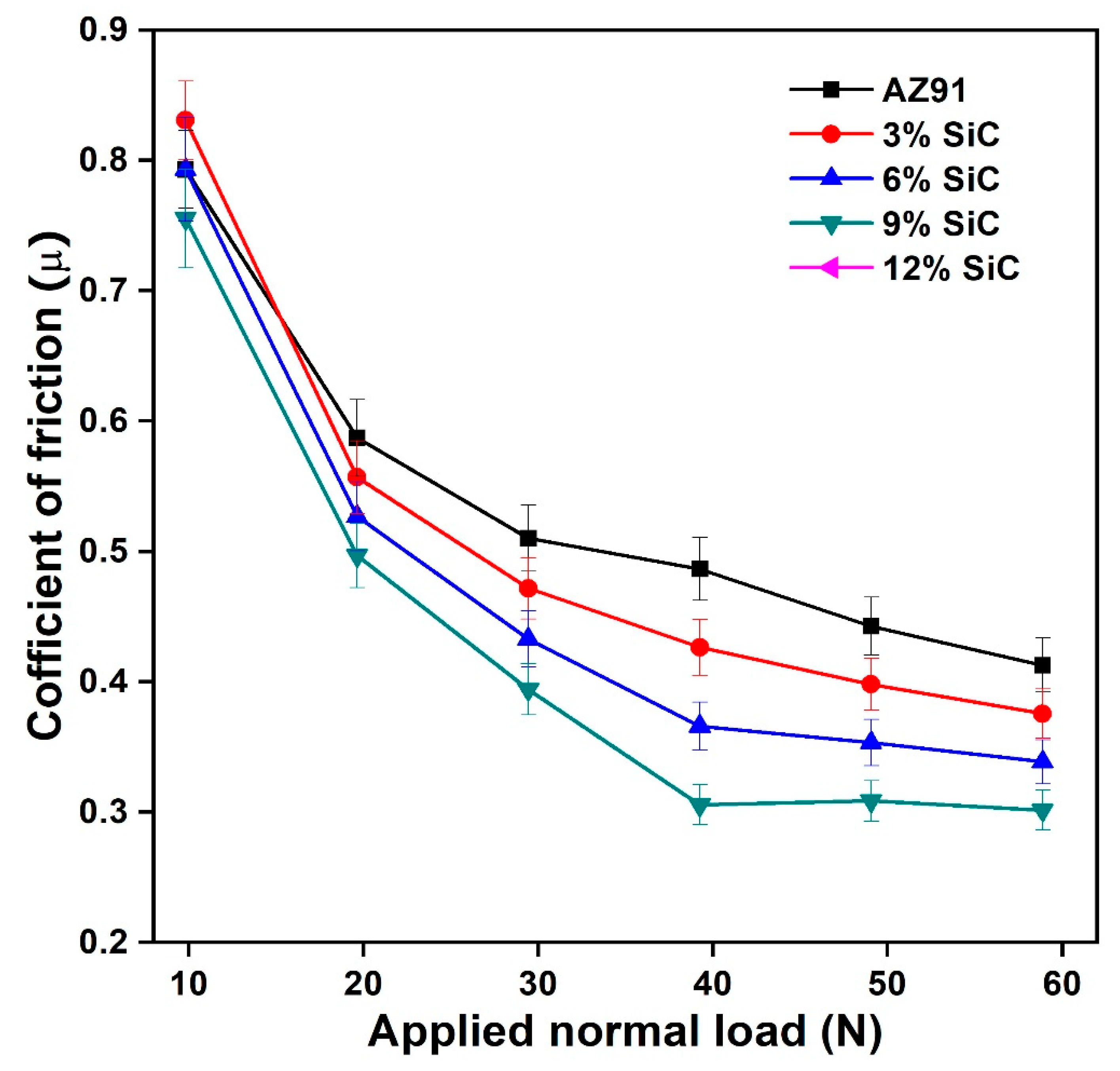
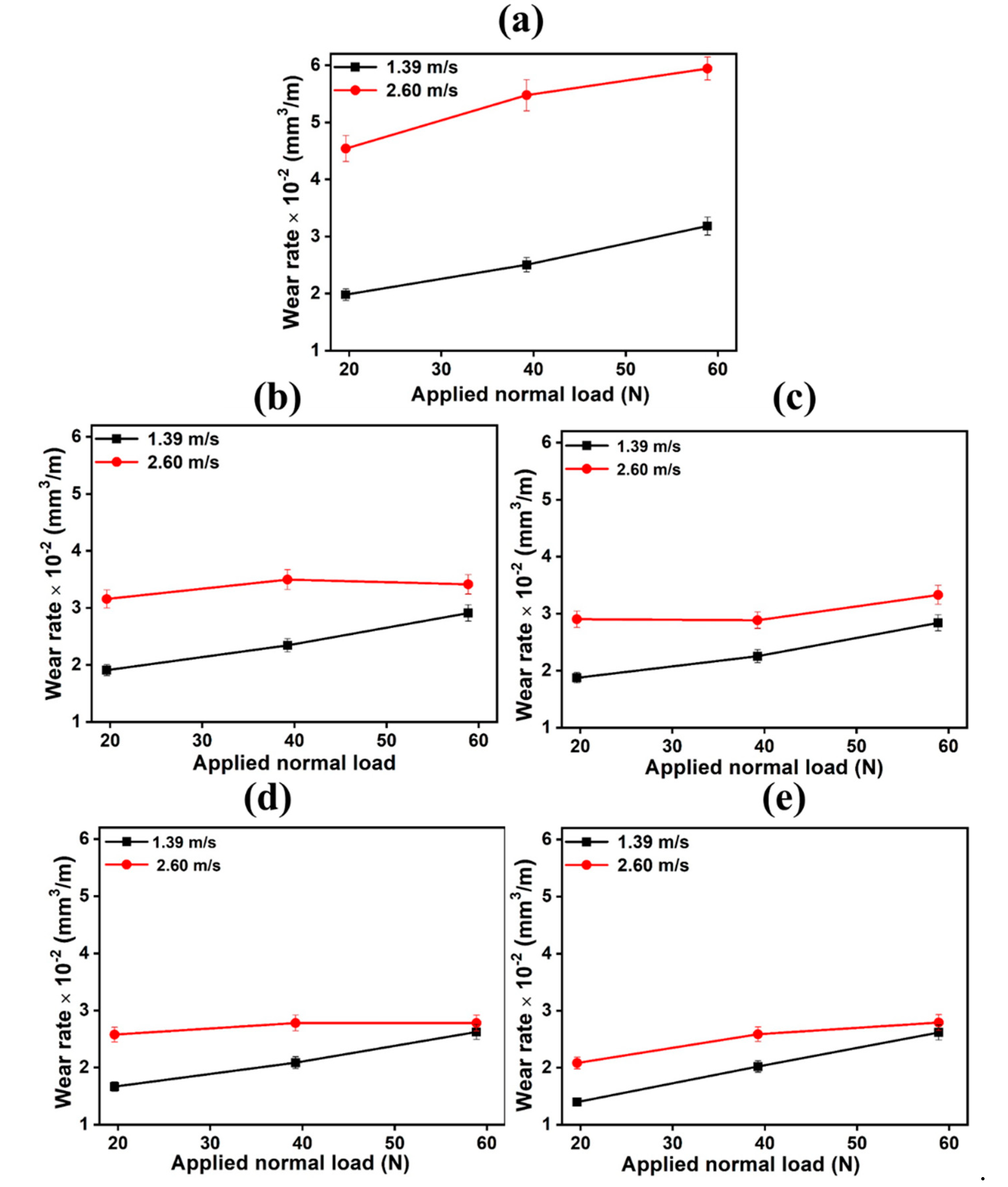
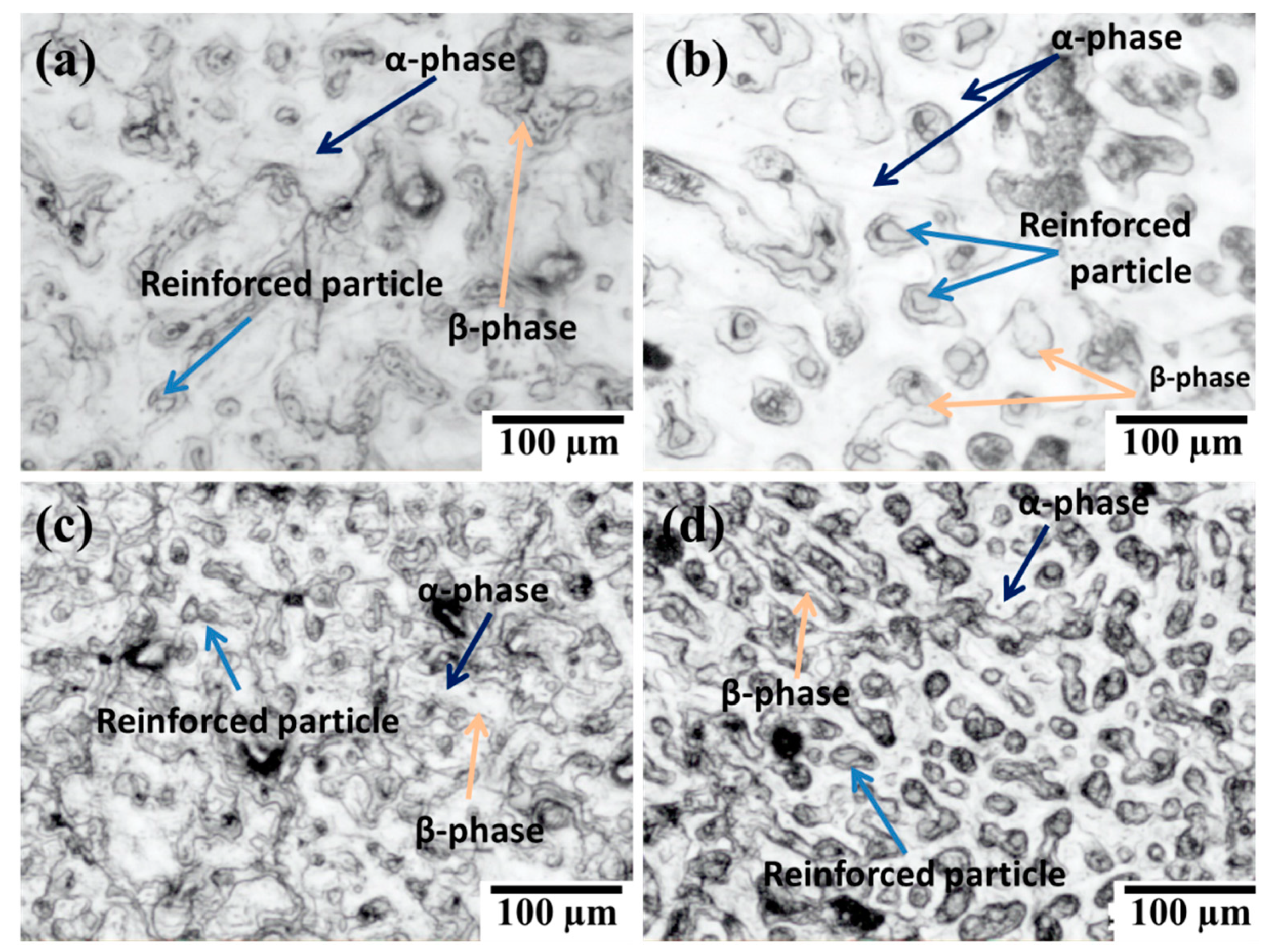
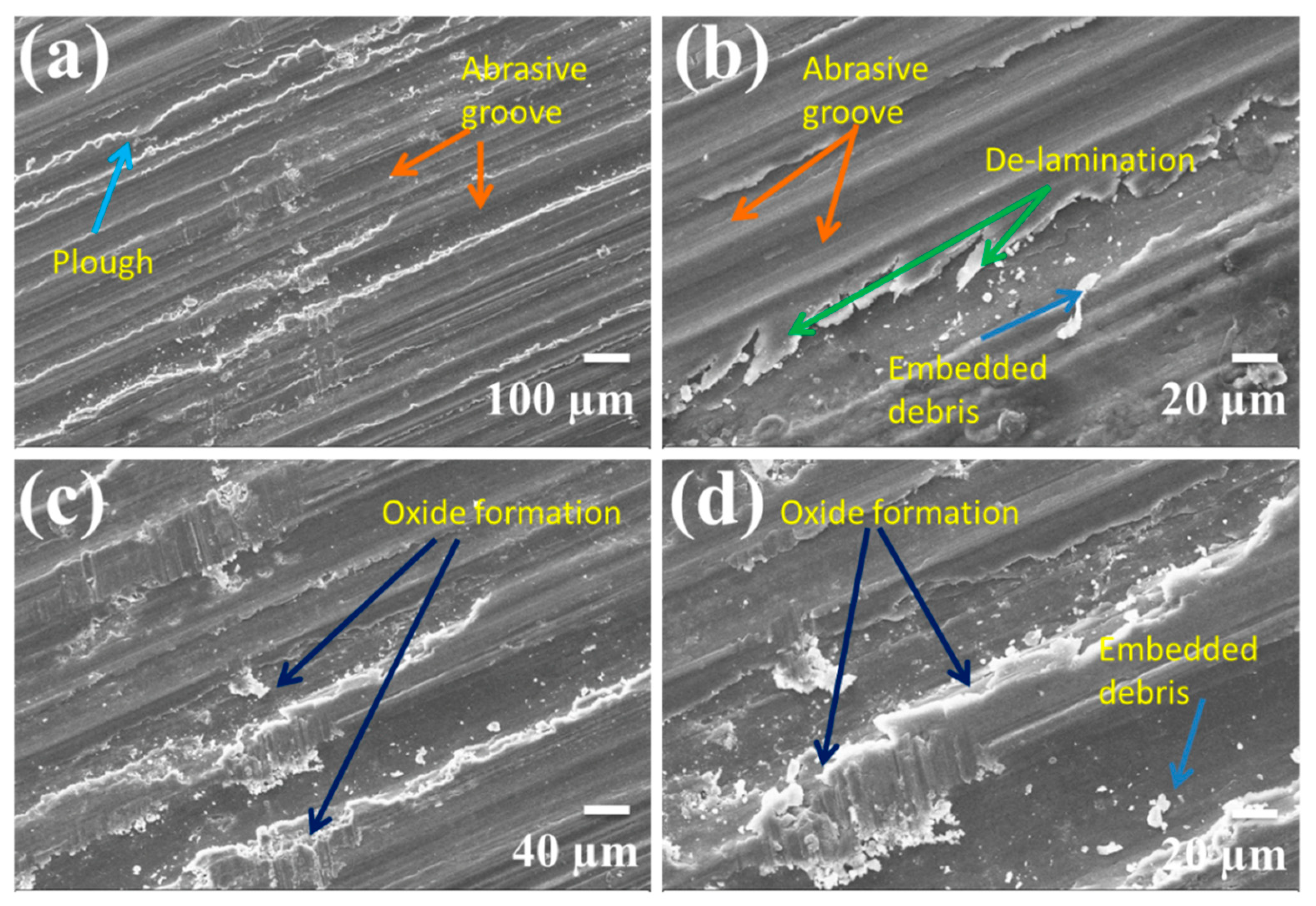
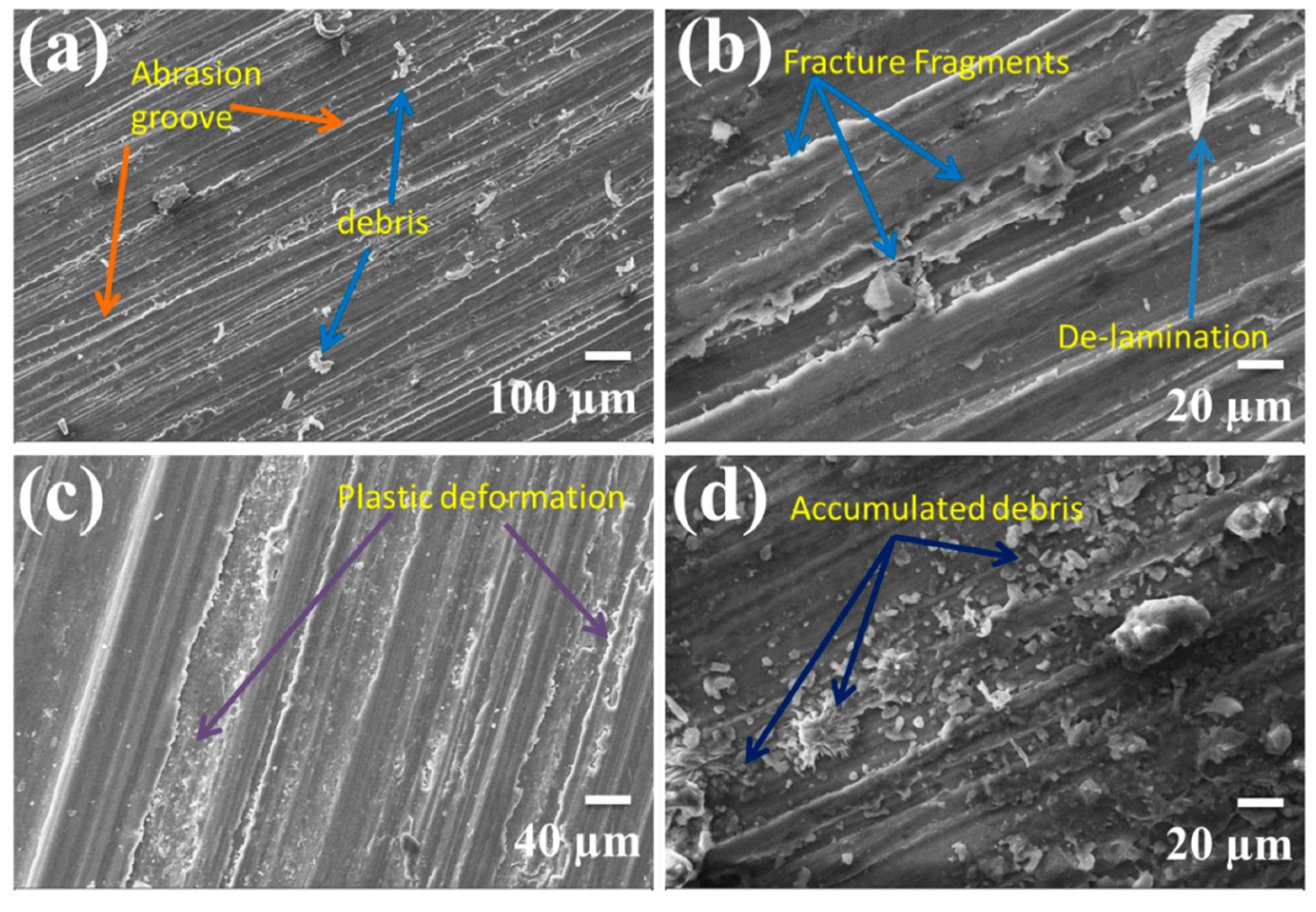

| Parameters | Value/Description |
|---|---|
| Pin Materials | AZ91 and its composite reinforced with SiC (3%, 6%, 9%, and 12%) |
| The Dimension of the Pin | 30 mm length and 8 mm in diameter |
| Disk Material | Tool steel grade EN31 |
| Track diameter (D) | 83 mm for all experiments |
| Load Variation (N) | 9.81 N, 19.62 N, 29.43 N, 39.24 N, 49.05 N, 58.86 N (for RPM-320) 19.62 N, 39.24 N, 58.86 N (for RPM-600) |
| Sliding Time (t) | 15 min |
| Speed Variation (n) | 320 RPM and 600 RPM |
| Load | Sliding Speed (m/s) | Pin Material | Wear Mechanism | ||||
|---|---|---|---|---|---|---|---|
| Abrasion | Oxidation | Delamination | Adhesion | Softening/Melting | |||
| 19.62 | 1.39 | AZ91 | * | ** | ** | ||
| AZ91+3% SiC | * | ** | ** | ||||
| AZ91+6% SiC | * | ** | ** | ||||
| AZ91+9% SiC | * | ** | ** | ||||
| AZ91+12% SiC | * | ** | ** | ||||
| 19.62 | 2.6 | AZ91 | * | * | ** | * | |
| AZ91+3% SiC | * | * | ** | * | |||
| AZ91+6% SiC | * | * | ** | * | |||
| AZ91+9% SiC | * | * | ** | * | |||
| AZ91+12% SiC | * | * | ** | * | |||
| 39.24 | 1.39 | AZ91 | ** | ** | * | ** | |
| AZ91+3% SiC | ** | ** | * | ** | |||
| AZ91+6% SiC | ** | ** | * | ** | |||
| AZ91+9% SiC | ** | ** | * | ** | |||
| AZ91+12% SiC | ** | ** | * | ** | |||
| 39.24 | 2.6 | AZ91 | ** | * | * | ** | |
| AZ91+3% SiC | ** | * | * | ** | |||
| AZ91+6% SiC | ** | * | * | ** | |||
| AZ91+9% SiC | ** | * | * | ** | |||
| AZ91+12% SiC | ** | * | * | ** | |||
| 58.86 | 1.39 | AZ91 | * | *** | |||
| AZ91+3% SiC | * | *** | |||||
| AZ91+6% SiC | * | *** | |||||
| AZ91+9% SiC | * | *** | |||||
| AZ91+12% SiC | * | *** | * | ||||
| 58.86 | 2.6 | AZ91 | * | *** | * | ||
| AZ91+3% SiC | * | *** | * | ||||
| AZ91+6% SiC | * | *** | * | ||||
| AZ91+9% SiC | * | *** | * | ||||
| AZ91+12% SiC | * | *** | * | ||||
Publisher’s Note: MDPI stays neutral with regard to jurisdictional claims in published maps and institutional affiliations. |
© 2021 by the authors. Licensee MDPI, Basel, Switzerland. This article is an open access article distributed under the terms and conditions of the Creative Commons Attribution (CC BY) license (http://creativecommons.org/licenses/by/4.0/).
Share and Cite
Kumar, A.; Kumar, S.; Mukhopadhyay, N.K.; Yadav, A.; Kumar, V.; Winczek, J. Effect of Variation of SiC Reinforcement on Wear Behaviour of AZ91 Alloy Composites. Materials 2021, 14, 990. https://doi.org/10.3390/ma14040990
Kumar A, Kumar S, Mukhopadhyay NK, Yadav A, Kumar V, Winczek J. Effect of Variation of SiC Reinforcement on Wear Behaviour of AZ91 Alloy Composites. Materials. 2021; 14(4):990. https://doi.org/10.3390/ma14040990
Chicago/Turabian StyleKumar, Anil, Santosh Kumar, Nilay Krishna Mukhopadhyay, Anshul Yadav, Virendra Kumar, and Jerzy Winczek. 2021. "Effect of Variation of SiC Reinforcement on Wear Behaviour of AZ91 Alloy Composites" Materials 14, no. 4: 990. https://doi.org/10.3390/ma14040990







